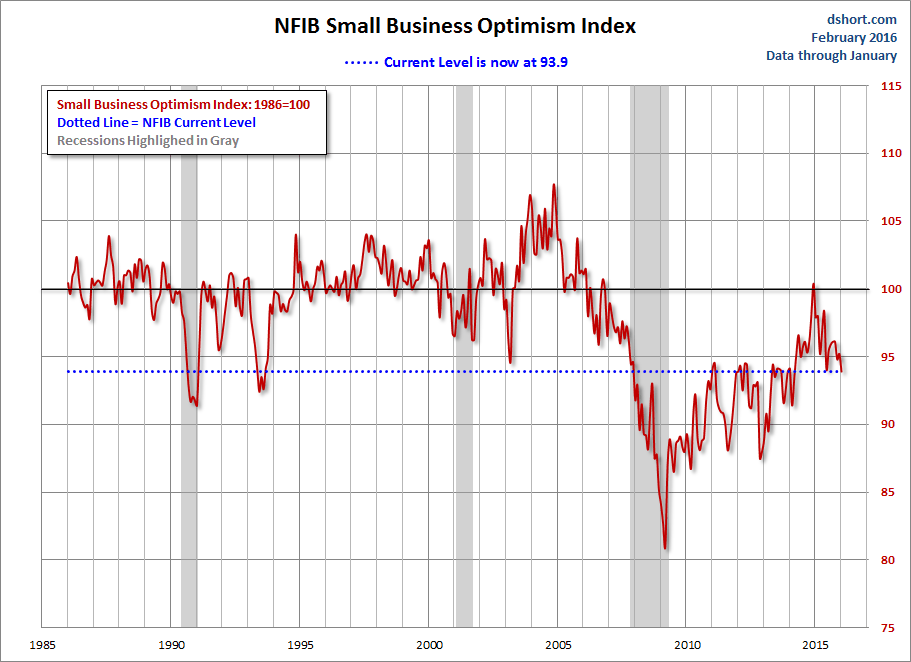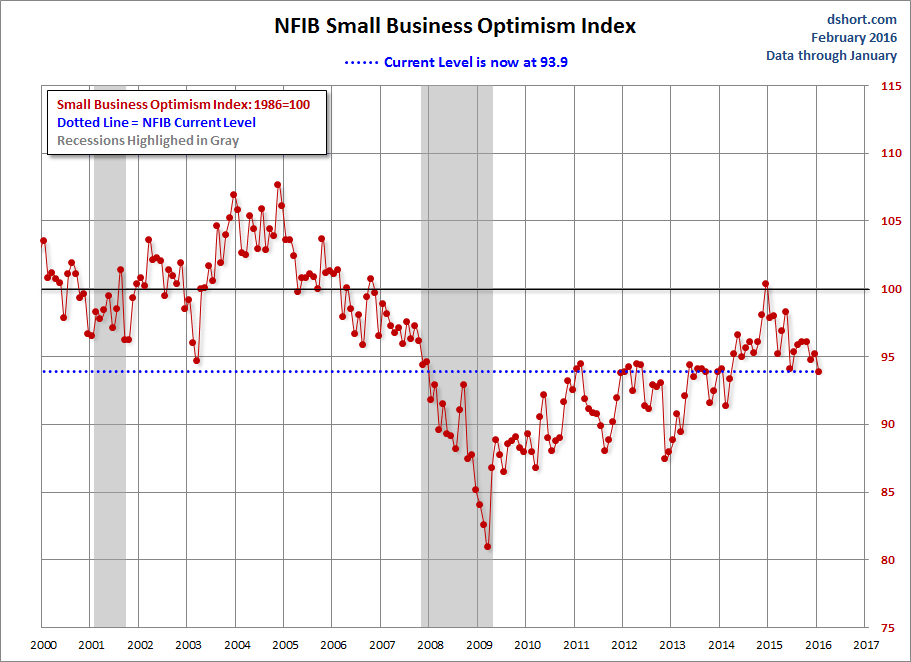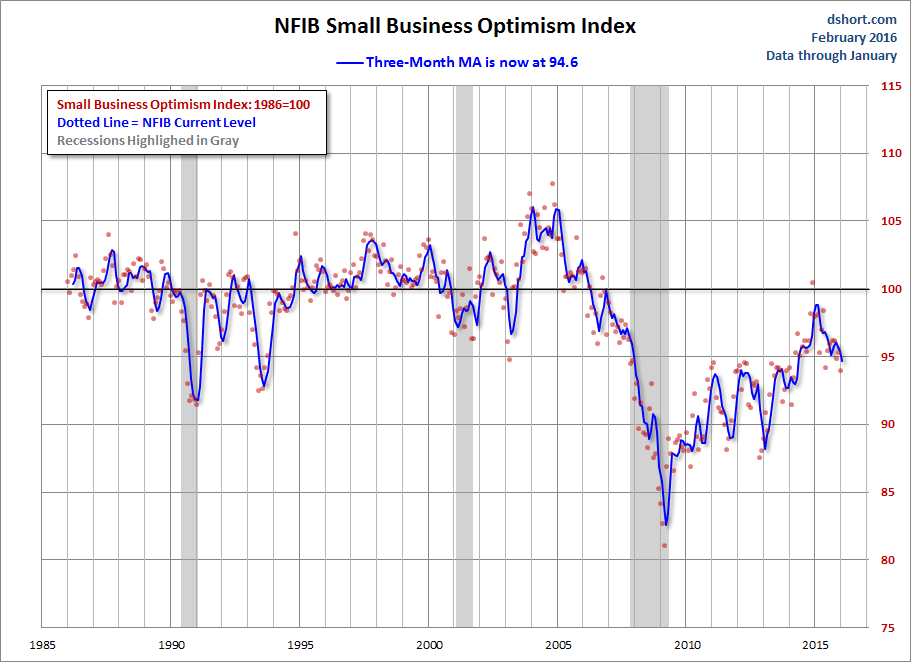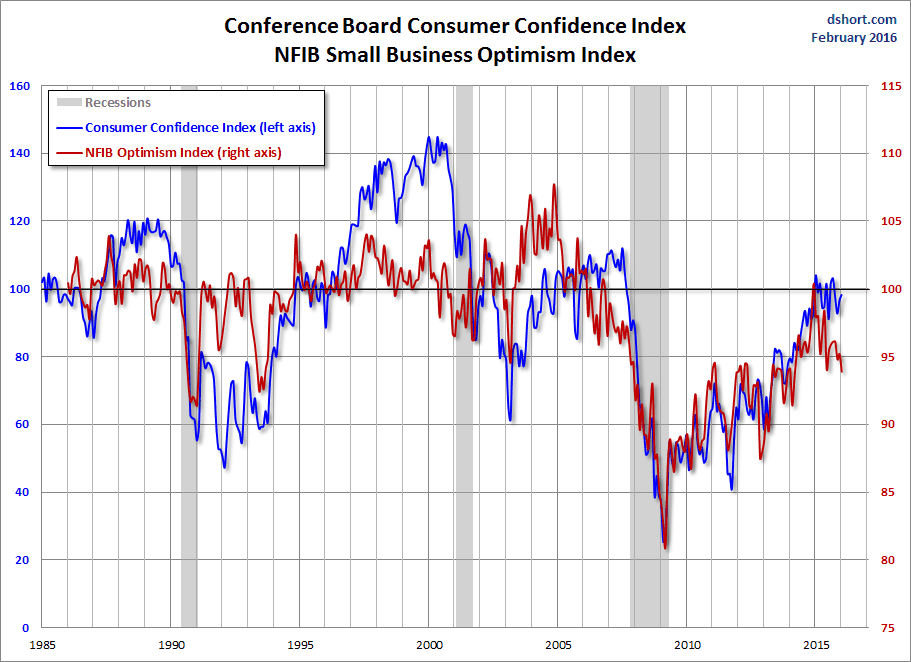The latest issue of the NFIB Small Business Economic Trends is out. The headline number for January came in at 93.9, down 1.3 from the previous month's 95.2. The index is at the 20th percentile in this series.
Today's number came in below the Investing.com forecast of a decrease to 94.6.
Here is an excerpt from the opening summary of the news release.
NFIB survey shows small business owners wary of future economic conditions.
"The decline in optimism was accounted for by two important Index components, expected business conditions in six months and expected real sales. These expectations are important determinants of decisions to hire, to expand business operations and to order new inventory, all drivers of economic growth."
"Overall, it is unlikely that anything will occur that will raise the spirits of small business owners and rekindle the “animal spirits” that are needed to spur economic growth."
— Bill Dunkelberg, NFIB Chief Economist
The first chart below highlights the 1986 baseline level of 100 and includes some labels to help us visualize that dramatic change in small-business sentiment that accompanied the Great Financial Crisis. Compare, for example the relative resilience of the index during the 2000-2003 collapse of the Tech Bubble with the far weaker readings following the Great Recession that ended in June 2009.

Here is a closeup of the indicator since the turn of the century.

The average monthly change in this indicator is 1.3 points. To smooth out the noise of volatility, here is a 3-month moving average of the Optimism Index along with the monthly values, shown as dots.

Here are some excerpts from the report.
Labor Markets
Reported job creation improved in January, with the average employment gain per firm rising to 0.11 workers per firm from -0.07 workers in December. Twelve percent (down 1 point) reported increasing employment an average of 2.8 workers per firm while 11 percent (down 1 point) reported reducing employment an average of 3.9 workers per firm. The size of the average reduction in employment was large after seasonal adjustment, perhaps reflecting abnormal adjustments produced by a shift from abnormally warm weather through December to normal winter weather.
Inflation
How effective has the Fed's monetary policy been in lifting inflation to it two percent target rate?
Seasonally adjusted, the net percent of owners raising selling prices was negative 4 percent. Obviously more evidence that the Fed’s policies aimed at producing inflation are not working. It appears that there was a lot of price cutting late in the year to boost sales and reduce inventory.
Credit Markets
Has the Fed's zero interest rate policy and quantitative easing had a positive impact on Small Businesses?
Three percent of owners reported that all their borrowing needs were not satisfied, 1 point above the record low reached in September, 2015. Thirty-five percent reported all credit needs met (up 3 points), and 50 percent explicitly said they did not want a loan. For most of the recovery, record numbers of firms have been on the “credit sidelines”, seeing no good reason to borrow. Only 2 percent reported that financing was their top business problem compared to 21 percent citing taxes, 18 percent citing regulations and red tape and 15 percent citing the availability of qualified labor. The allegation that large numbers of real operating firms are being denied credit is clearly not the case. When credit is an issue, owners report it as illustrated by 37 percent reporting credit hard to get in the early 1980s compared to 5 percent today.
NFIB Commentary
This month's "Commentary" section includes the following observations:
The Bureau of Economic Analysis reported its first estimate of real GDP growth in 2015 Q4 at 0.7 percent, a very weak performance. The Bureau of Labor Statistics reported job creation in January at about 150,000. December’s number was revised down to 262,000, still more than most analysts, including those with independent data sources. So what are all those workers making? It’s not showing up in GDP. The unemployment rate fell to 4.9 percent but the percent of the adult population with a job remained historically low. The State of the Union address tried to put lipstick on the pig that is our recovery and of course shift the blame for the recession to predecessors. There was little there to lift the spirits of Main Street business owners. The litany was old and worn.
Business Optimism and Consumer Confidence
The next chart is an overlay of the Business Optimism Index and the Conference Board Consumer Confidence Index. The consumer measure is the more volatile of the two, so it is plotted on a separate axis to give a better comparison of the volatility from the common baseline of 100.

These two measures of mood have been highly correlated since the early days of the Great Recession.
